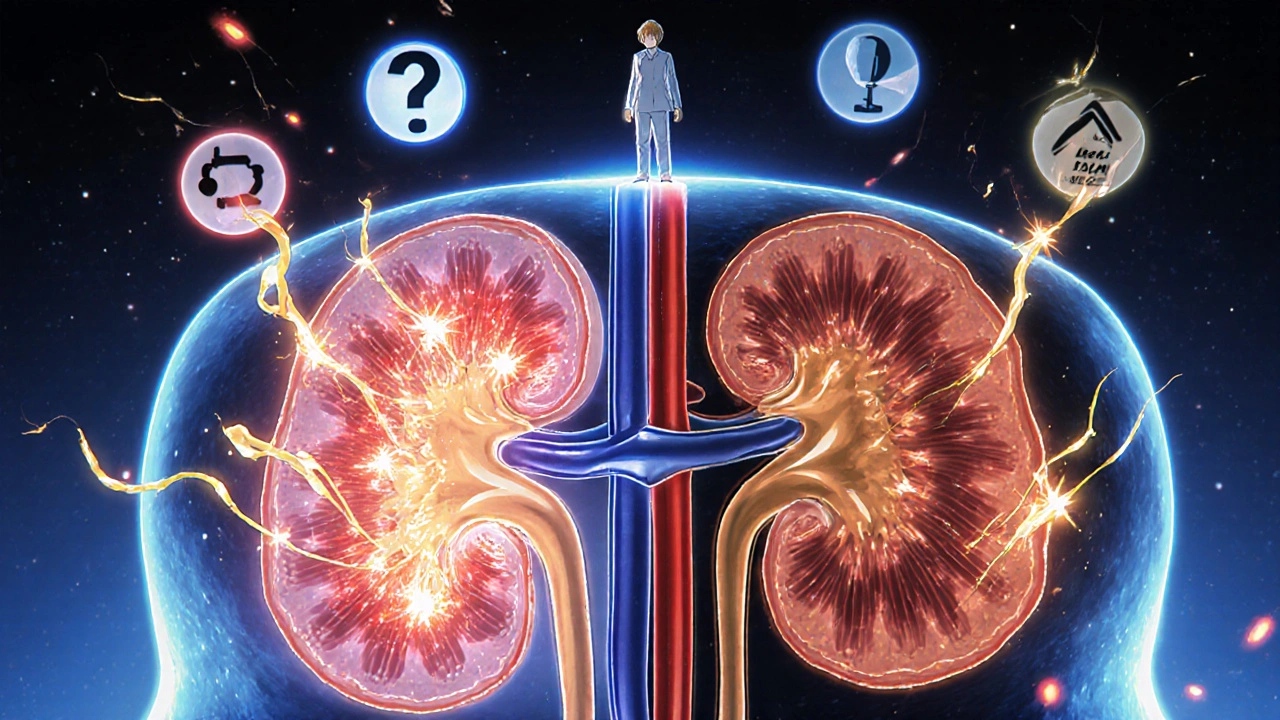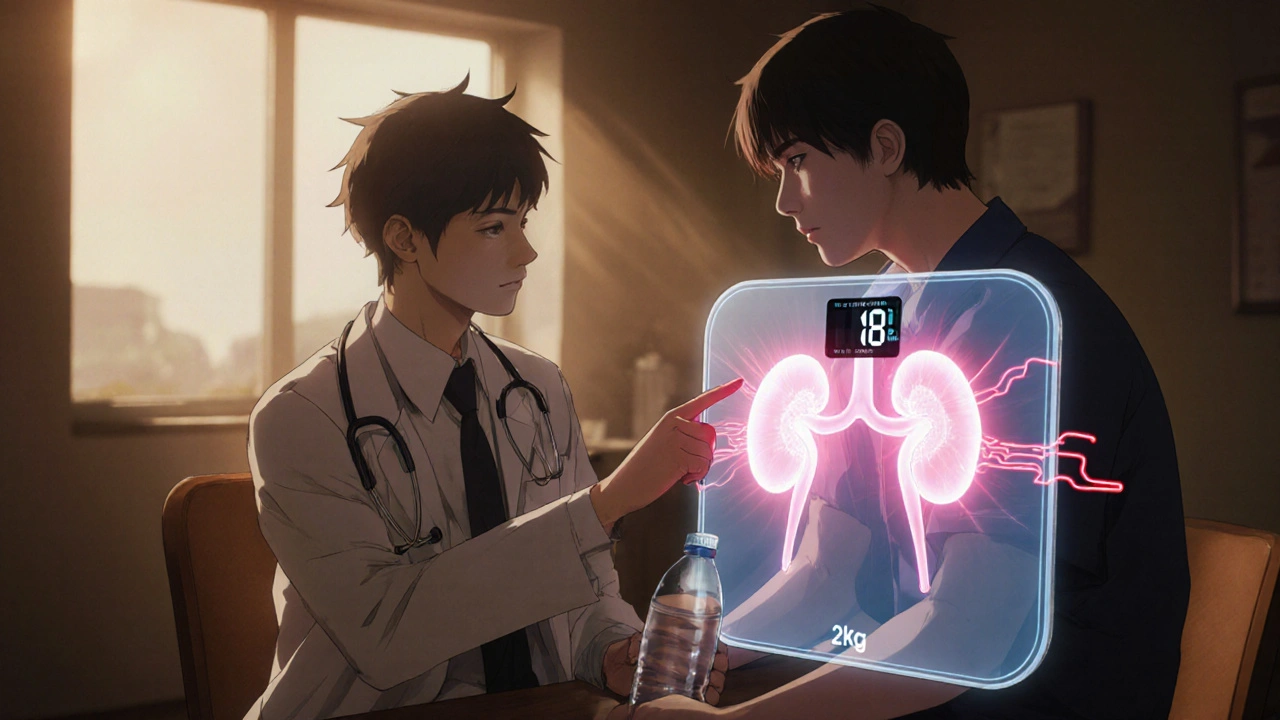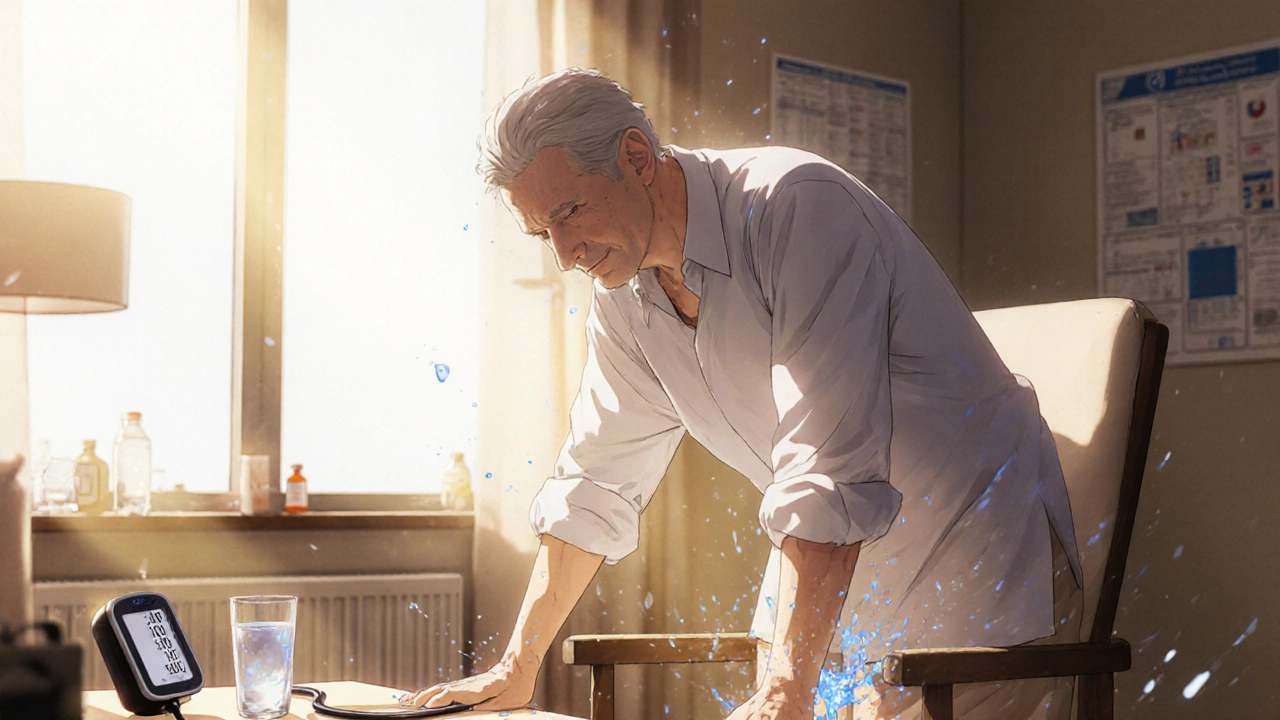SGLT2 Inhibitor Fluid Loss Calculator
This calculator estimates how much fluid you may lose based on glucose excretion while taking SGLT2 inhibitor medications. Remember to drink extra fluids to prevent dehydration and dizziness.
SGLT2 inhibitors pull glucose from your bloodstream into urine. For every gram of sugar excreted, you lose about 3.4 mL of fluid.
Example: If you excrete 80 grams of glucose per day, you'd lose approximately 272 mL of fluid (80 × 3.4).
Fluid Loss Estimate
Enter your glucose excretion to see fluid loss
Recommended Hydration
Enter your data to see hydration recommendation
For every 10 grams of glucose excreted, add 34 mL of fluid (about 1.25 ounces).
Important: If you're over 65, have kidney disease, or take diuretics, consult your doctor before adjusting your hydration plan.
When you start taking an SGLT2 inhibitor for type 2 diabetes, you might not expect to feel lightheaded or unusually thirsty. But these side effects aren’t rare-they’re built into how the drug works. SGLT2 inhibitors like empagliflozin, dapagliflozin, and canagliflozin don’t just lower blood sugar. They also act like mild diuretics, pulling extra water and salt out of your body through urine. That’s why some people feel dizzy, dehydrated, or notice their blood pressure dropping. Understanding this connection can help you stay safe while getting the full benefits of the medication.
How SGLT2 Inhibitors Work: More Than Just Sugar Control
These drugs block a protein in your kidneys called SGLT2, which normally reabsorbs glucose back into your bloodstream. When it’s blocked, about 70 to 100 grams of sugar spill into your urine every day. That’s roughly 300 to 400 calories lost per day-similar to walking an extra mile. But here’s the catch: glucose doesn’t leave alone. It drags sodium and water with it. For every gram of sugar excreted, you lose about 3.4 mL of fluid. That adds up to 1 to 1.5 liters of extra urine in the first week.
This isn’t a bug-it’s a feature. That fluid loss is why these drugs help people with heart failure. Less fluid means less strain on the heart. But for some, especially older adults or those already on blood pressure meds, it can go too far. The same mechanism that protects your kidneys and heart can also leave you feeling drained.
Why Dehydration Happens-and Who’s Most at Risk
Dehydration from SGLT2 inhibitors isn’t just about drinking less water. It’s about your body losing more than it’s replacing. Clinical trials show that 1.3% to 2.8% of people taking these drugs experience volume depletion symptoms: dry mouth, dark urine, fatigue, or even fainting. That’s nearly three times higher than placebo.
Some people are far more vulnerable:
- Those over 65, especially if they don’t feel thirsty as easily
- People with kidney function below 60 mL/min (eGFR)
- Anyone taking diuretics like furosemide or hydrochlorothiazide
- Those with systolic blood pressure under 120 mmHg
- Patients during hot weather, illness, or after intense exercise
In one study, older adults had more than twice the risk of hospitalization for dehydration compared to younger users. If you’re on one of these meds and you’ve had a bout of food poisoning, the flu, or even just skipped meals and fluids for a day, your risk spikes. That’s why doctors often advise holding the medication during acute illness.
Dizziness Isn’t Just ‘Getting Used to It’-It’s a Warning Sign
Dizziness is the most common reason people stop taking SGLT2 inhibitors. About 4% to 6% of users report it, compared to just 2.5% to 3% on placebo. But here’s what most don’t realize: it’s rarely random. In over 60% of cases, it’s tied to orthostatic hypotension-your blood pressure drops too much when you stand up.
When you rise from a chair or bed, your body normally adjusts by tightening blood vessels and increasing heart rate. But if you’ve lost fluid volume from the drug, your body can’t compensate fast enough. The result? A sudden drop in blood flow to your brain. You feel dizzy, maybe even see spots.
Studies show this usually happens within the first four weeks. It’s not a sign you’re allergic-it’s a sign your fluid balance is off. Risk factors include:
- Age 75 or older
- Already on blood pressure medications
- Baseline systolic pressure under 130 mmHg
- Diabetes-related nerve damage (autonomic neuropathy)
One patient on Reddit wrote: “Started Jardiance last week. Got dizzy standing up. My doctor said it’s normal for the first month.” That’s true-but it doesn’t mean you should ignore it.

Why Blood Pressure Drops-and Why That’s Actually Good (Mostly)
SGLT2 inhibitors consistently lower blood pressure. On average, systolic pressure drops by 4 to 6 mmHg, and diastolic by 1 to 2 mmHg. That’s similar to what you’d see with a low-dose thiazide diuretic. But unlike traditional diuretics, this drop isn’t just from losing fluid. These drugs also improve how flexible your arteries are and reduce stiffness in blood vessel walls.
That’s why they’re now recommended for heart failure-even in people without diabetes. In the EMPEROR-Reduced trial, empagliflozin cut cardiovascular death by 25% in heart failure patients. The blood pressure drop plays a role, but so do other effects: less fluid overload, reduced inflammation, and better heart muscle function.
Still, if your blood pressure was already low (below 110 mmHg systolic), this drop can be dangerous. One study found people with baseline systolic pressure under 120 mmHg had more than three times the risk of symptomatic low blood pressure. That’s why doctors check your blood pressure before starting and again after one week.
What to Do If You Feel Dizzy or Dehydrated
Don’t stop the medication on your own. But don’t ignore the symptoms either. Here’s what works:
- Drink more water. Add 500 to 1,000 mL (about 2 to 4 cups) daily, especially in heat or during exercise. Don’t wait until you’re thirsty.
- Check your blood pressure standing and sitting. If your systolic drops more than 20 mmHg when you stand, tell your doctor. This is a red flag.
- Monitor your weight. A sudden drop of more than 2 kg (4.4 lbs) in a week could mean too much fluid loss.
- Hold the drug during illness. If you have vomiting, diarrhea, or can’t eat/drink normally, pause the medication until you’re stable.
- Ask about dose adjustment. Instead of stopping, your doctor might lower the dose-like switching from 25 mg empagliflozin to 10 mg.
- Review other meds. If you’re on a diuretic, your doctor might reduce its dose by 25-50% to balance things out.
Many patients find that dizziness fades after 3 to 4 weeks as their body adjusts. But if it persists, it’s not worth risking falls or fainting. Your doctor can help you weigh the benefits-like lower heart failure risk and better kidney protection-against the discomfort.

Who Should Avoid SGLT2 Inhibitors?
These drugs aren’t right for everyone. Avoid them if you:
- Have severe kidney disease (eGFR under 30 mL/min)
- Have a history of recurrent volume depletion or orthostatic hypotension
- Are on high-dose diuretics and can’t tolerate fluid loss
- Are frail, elderly, or have poor oral intake
For people with heart failure, the benefits usually outweigh the risks-even if they’re older. But for someone with stable diabetes and no heart or kidney issues, the side effects might not be worth it. Talk to your doctor about whether the trade-off makes sense for you.
Real-World Experience: What Patients Say
On patient forums, stories vary. One person wrote: “Canagliflozin made me so dehydrated I had to stop after 3 weeks-constant thirst but dry mouth.” Another said: “Jardiance lowered my BP from 140 to 120. I feel better, and my dizziness faded after two weeks.”
What separates success from trouble? Early monitoring. Patients who checked their blood pressure and fluid intake in the first week were far less likely to have serious side effects. Those who didn’t adjust their habits often ended up in the ER.
Bottom Line: Benefits Outweigh Risks-if You’re Careful
SGLT2 inhibitors are powerful tools. They lower blood sugar, protect your heart, and slow kidney damage. But they’re not harmless. The diuretic effect is real, and so are the risks of dehydration and dizziness. The key isn’t avoiding them-it’s managing them. Drink more water. Watch for dizziness when standing. Check your blood pressure. Talk to your doctor before and after starting. With the right approach, you get the benefits without the downsides.









Comments (14)
Melvina Zelee
November 24, 2025 AT 01:48 AMso i started jardiance last month and yeah the dizziness hit me hard like day 3. thought i was dying. turned out i was just dehydrated as hell. now i drink a whole liter of water before bed and boom, no more spinning when i stand up. its not magic, its just physics.
steve o'connor
November 25, 2025 AT 01:54 AMthe fact that this drug makes you lose 70-100g of sugar daily is wild. that’s like eating a whole bag of gummy bears and pooping them out. no wonder people lose weight. but yeah, if you’re old or on other meds, it’s a tightrope walk.
Robin Johnson
November 25, 2025 AT 23:43 PMif you’re dizzy, don’t ignore it. i had a patient faint in the clinic last week. turned out he was on canagliflozin + hydrochlorothiazide + had a cold. triple threat. check your bp standing up. it’s that simple. no drama, just data.
Latonya Elarms-Radford
November 27, 2025 AT 23:30 PMoh wow. so we’re just… accepting that our kidneys are now serving as a sugar-filtering espresso machine? i mean, isn’t this just nature’s way of saying ‘you’re too attached to glucose, my dear’? it’s poetic. like a biochemical zen koan. we are not our blood sugar. we are the space between the glucose and the urine. the void that holds the equilibrium. the quiet sigh of the nephron. i’m crying. this is beautiful.
Mark Williams
November 29, 2025 AT 18:40 PMthe osmotic diuresis mechanism is well-documented. the 3.4 mL fluid per gram of glucose excreted aligns with renal physiology models. what’s underdiscussed is the sodium-potassium flux secondary to glucosuria. this can induce subtle hypokalemia, exacerbating orthostasis. monitor electrolytes in high-risk cohorts.
Daniel Jean-Baptiste
December 1, 2025 AT 06:29 AMmy dad took this med and got dizzy all the time. we just told him to sit up slow and drink more water. no big deal. also he stopped the meds when he had the flu. simple stuff. dont overcomplicate it
Ravi Kumar Gupta
December 3, 2025 AT 01:45 AMin india we call this ‘sugar leakage’ - and yes, it works. but my uncle, 72, got so weak he couldn’t walk. doctor said ‘hold the pill’. he did. he’s fine now. why do western docs make it sound like rocket science? it’s just water and salt going out. drink more. sit slow. done.
Rahul Kanakarajan
December 3, 2025 AT 16:40 PMwhy are people still on this drug if they feel dizzy? just stop. it’s not that hard. you think your kidneys are special? they’re not. if you can’t handle losing a little fluid, maybe you shouldn’t be on a diuretic. also why are you drinking so little water anyway? it’s 2025. water is free.
New Yorkers
December 3, 2025 AT 22:10 PMoh so now the medical establishment is selling us diuretics as ‘heart protectors’? classic. next they’ll say losing your sweat is ‘anti-inflammatory’. this is why i don’t trust pharma. you’re not fixing diabetes. you’re just making your body leak. and calling it a ‘feature’? please. i’ve seen more integrity in a vending machine.
David Cunningham
December 4, 2025 AT 05:27 AMchill. i’ve been on dapagliflozin for 18 months. dizziness lasted two weeks. now i feel like a new man. lost 8kg. bp down. no more midnight snacks. if you’re gonna complain, at least try it for a month first. and drink water. it’s not that hard.
luke young
December 6, 2025 AT 01:48 AMjust wanted to say thanks for writing this. i’ve been scared to ask my doc about the dizziness. now i know it’s normal but still needs attention. gonna start drinking more and checking my bp. really appreciate the practical tips.
james lucas
December 7, 2025 AT 01:42 AMso i started this med and thought i was going crazy. kept thinking i was dehydrated but kept drinking and still felt like a desert. then i realized - i was drinking water but not adding salt. tried adding a pinch to my water. boom. dizziness gone. my doc was like ‘huh, weird’ but it worked. maybe its the sodium loss messing with my nerves. try it. its free.
Jessica Correa
December 7, 2025 AT 18:58 PMmy mom took this and got really weak. she didn’t tell anyone because she didn’t want to stop. then she fell in the shower. now she’s on a lower dose and drinks coconut water. i wish someone had told us earlier. please tell your patients to watch for falls
manish chaturvedi
December 8, 2025 AT 04:35 AMin traditional indian medicine, we refer to this phenomenon as ‘mootra vikriti’ - abnormal urinary excretion. the body expels excess kapha and pitta through urine. while modern pharmacology describes SGLT2 inhibition, the underlying principle of fluid balance and metabolic detoxification aligns closely. patients should be advised to consume warm water with ginger and cumin, and avoid cold beverages during initial therapy.